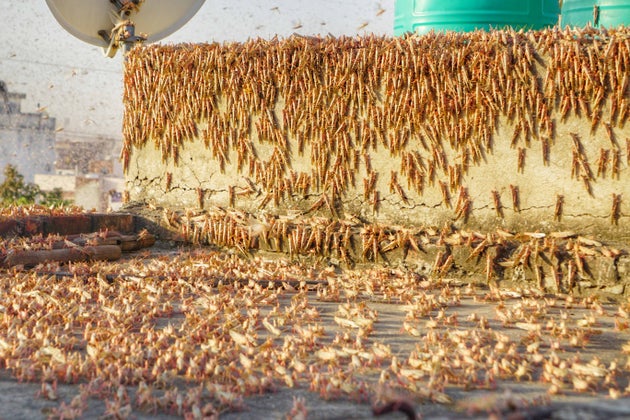
After Rajasthan, Are Locusts Heading To Delhi? Here's What We Know
Can locusts harm humans? How big are swarms? Your questions answered.
by Akshita JainAfter locusts attacked crops in Rajasthan and Madhya Pradesh, other states like Chhattisgarh and Delhi were also put on alert.
Earlier reports said swarms of locusts which entered some residential areas of Jaipur on Monday could move towards Delhi if wind conditions are favourable, according. The Times of India said that IMD is monitoring the meteorological conditions to help the agriculture ministry in determining where the locusts are headed.
Kuldeep Srivastava, scientist at IMD and head of Regional Weather Forecasting Centre in Delhi, was quoted in the report as saying that wind direction is favourable at the moment, “largely remaining northwesterly”.
However, a change in wind direction has helped Delhi avoid the locusts for now, according to a Business Today report on Thursday. The South Eastern direction of the wind has taken the locust swarms towards Madhya Pradesh, a senior official of India’s Locust Control Office (LCO) was quoted as saying in the report.
This is the second round of locust attacks in India with the first one being in the December-February months over 2019 and 2020. The desert locust is one of about a dozen species of short-horned grasshoppers that are known to change their behavior and form swarms of adults or bands of hoppers, according to the UN’s Food and Agriculture Organisation (FAO).
How big are swarms?
Locust swarms can vary from less than one square kilometre to several hundred square kilometres, FAO said, and there can be at least 40 million and sometimes as many as 80 million locust adults in each square kilometre of swarm.
The organisation said that a desert locust adult can consume roughly its own weight in fresh food per day, that is about two grams every day. “This means that they not only devour valuable standing crops, but can also devastate livelihoods of those associated with the agricultural supply chain,” Hindustan Times said in its editorial.
Can locusts harm humans?
Locusts do not attack people or animals. There is no evidence that suggests that locusts carry diseases that could harm humans, the Food and Agriculture Organisation said.
Affected states
The locusts are currently active in Rajasthan, Gujarat, Maharashtra, Uttar Pradesh and Madhya Pradesh. Rajasthan is currently the worst-affected state, according to the Union Environment ministry
The Chhattisgarh agriculture department and farmers of districts bordering Madhya Pradesh and Maharashtra have been alerted.
Locusts have reached Amravati (Maharashtra) and Mandla (Madhya Pradesh) from Rajasthan and may enter the bordering districts of Chhattisgarh “in a day or two”, an official told PTI.
“Hence, the Central Integrated Pest Management Centre (CIPMC) has asked agriculture officials and farmers of the districts concerned to be aware of these insects and take precautionary measures,” a public relations official was quoted as saying by PTI.
Farmers have been advised to use pesticides like malathion, fenvalerate and quinalphos, to save their crops from locust attack, he said.
Farmers in Jabalpur in Madhya Pradesh are also preparing to combat a locust attack. Farmers, according to ANI, have arranged water tankers and chemicals to drive away locusts.
Jabalpur District Magistrate Bharat Yadav told ANI that locusts can be driven away by making loud sounds and spraying chemicals.
Locusts have damaged orange crop and vegetable plantations in some areas of Maharashtra’s Nagpur and Wardha districts.
Divisional Joint Director of Agriculture, Ravi Bhosle, told PTI that there are no major standing crops in fields except vegetables like brinjal because the Kharif season is yet to start.
“No major financial loss is caused for crops due to the locust attack. However, some patches of orange orchards and vegetable fields suffered damage due to the pests,” Bhosle said.
For the latest news and more, follow HuffPost India on Twitter, Facebook, and subscribe to our newsletter.
Effect on crops
Reuters pointed out that the government and agricultural experts do not foresee major crop damage for now as it is the lean season. However, it said experts have warned that locusts must be stopped in their tracks in the next couple of weeks to ensure that swarms do not end up devouring summer crops.
CNBC-TV18 said that the locust attack can impact the economy. Agri economist Devinder Sharma was quoted as saying, “This is an emergency and the damage can be quite extensive even as the state machinery is spraying pesticides and chemicals to control any swarms, the procuring of equipment, training field teams do take time.”
(With PTI and Reuters inputs)